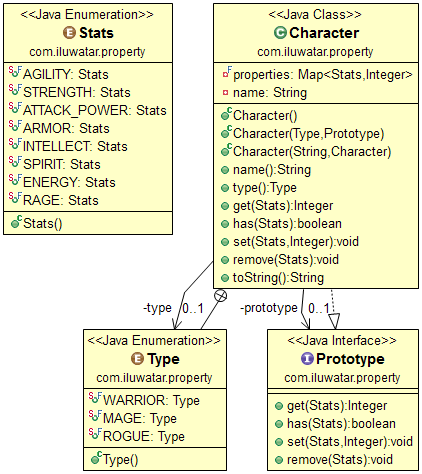Property
Intent
Create hierarchy of objects and new objects using already existing
objects as parents.
Explanation
Real-world example
In the mystical land of "Elandria", adventurers can harness the power of ancient relics to customize their abilities. Each relic represents a unique property or skill. As adventurers explore, they discover and integrate new relics, dynamically enhancing their skills based on the relics they possess.
Consider a modern software used in designing and customizing smartphones. Designers can choose from a variety of components such as processor type, camera specs, battery capacity, and more. Each component represents a property of the smartphone. As technology evolves and new components become available, designers can seamlessly add or replace properties to create a unique smartphone configuration without redefining the core design structure.
In plain words
Define and manage a dynamic set of properties for an object, allowing customization without altering its structure.
Programmatic Example
import java.util.HashMap;
import java.util.Map;
// Enumeration for possible properties or statistics a character can have
enum Stats {
AGILITY, ATTACK_POWER, ARMOR, INTELLECT, SPIRIT, FURY, RAGE;
}
// Enumeration for different types or classes of characters
enum Type {
WARRIOR, MAGE, ROGUE;
}
// Interface defining prototype operations on a character
interface Prototype {
Integer get(Stats stat);
boolean has(Stats stat);
void set(Stats stat, Integer value);
void remove(Stats stat);
}
// Implementation of the Character class
class Character implements Prototype {
private String name;
private Type type;
private Map<Stats, Integer> properties = new HashMap<>();
public Character() {}
public Character(Type type, Prototype prototype) {
this.type = type;
for (Stats stat : Stats.values()) {
if (prototype.has(stat)) {
this.set(stat, prototype.get(stat));
}
}
}
public Character(String name, Type type) {
this.name = name;
this.type = type;
}
@Override
public Integer get(Stats stat) {
return properties.get(stat);
}
@Override
public boolean has(Stats stat) {
return properties.containsKey(stat);
}
@Override
public void set(Stats stat, Integer value) {
properties.put(stat, value);
}
@Override
public void remove(Stats stat) {
properties.remove(stat);
}
@Override
public String toString() {
return "Character{name='" + name + "', type=" + type + ", properties=" + properties + '}';
}
}
// Main class to demonstrate the pattern
public class PropertyPatternDemo {
public static void main(String[] args) {
// Create a prototype character
Character prototypeWarrior = new Character("Proto Warrior", Type.WARRIOR);
prototypeWarrior.set(Stats.ATTACK_POWER, 10);
prototypeWarrior.set(Stats.ARMOR, 15);
// Create a new character using the prototype
Character newWarrior = new Character(Type.WARRIOR, prototypeWarrior);
newWarrior.set(Stats.AGILITY, 5);
System.out.println(prototypeWarrior);
System.out.println(newWarrior);
}
}
Program output:
Character{name='Proto Warrior', type=WARRIOR, properties={ARMOR=15, ATTACK_POWER=10}}
Character{name='null', type=WARRIOR, properties={ARMOR=15, AGILITY=5, ATTACK_POWER=10}}
Class diagram

Applicability
Use the Property pattern when
- When you like to have objects with dynamic set of fields and prototype inheritance
Real world examples
- JavaScript prototype inheritance